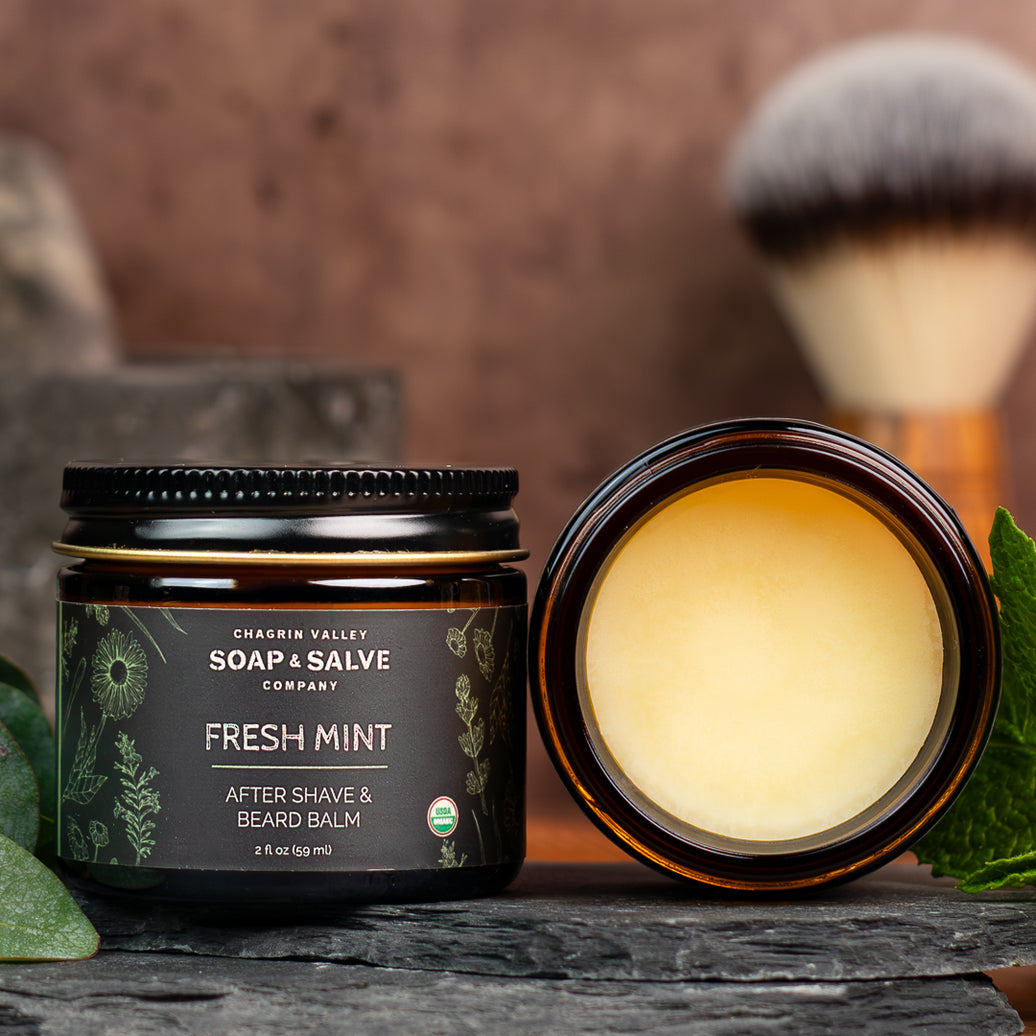
After Shave & Beard Balm: Fresh Mint
- Out Of Stock
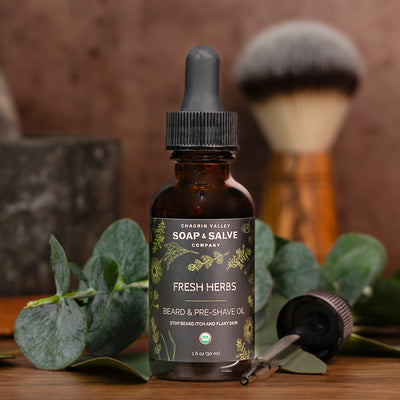
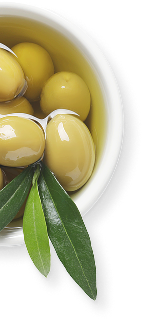
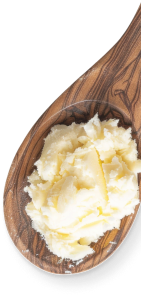
Excellent for all skin types, this organic beard, mustache, and pre-shave oil has a crisp, clean scent. As a beard oil, it softens and smooths the beard while it moisturizes and nourishes the skin. It helps with skin irritation and flaking, softens coarse beard hair, and promotes strong, healthy beard growth. As a pre-shave oil, it helps soften facial hair and protect facial skin from razor burn and irritation by improving glide.






Excellent for all skin types, our organic beard and mustache oil contains an organic blend of nourishing oils to soften and smooth the beard while it moisturizes and nourishes skin. It helps with skin irritation and flaking, softens coarse beard hair and promotes strong, healthy beard growth. The blend of natural plant oils moisturizes the skin exceptionally well, reducing beard dryness which can help prevent beard dandruff and the dreaded itchy beard.
Our Beard Oils can also be used as a pre-shave oil to prepare skin before shaving. Facial hair can be tough and coarse, making it difficult to achieve a smooth shave. Applying a facial oil after cleansing and before shaving helps soften the hair, moisturize the skin, and reduce friction between the razor and skin. It also helps to prevent razor burns, bumps, and irritation by improving glide which reduces tugging and pulling.
Jojoba is light, non-comedogenic, emollient oil that quickly absorbs to the skin and beard without leaving your face looking oily and greasy. The naturally occurring vitamin E adds great moisturizing benefits to the facial hair and the skin underneath. Your facial skin will be silky smooth and your beard hairs will be soft and shiny.
Argan is a light oil known for its superb moisturizing qualities – two properties that make a great beard conditioner. It is also rich in naturally occurring vitamin E, which nourishes the beard. It is a wonderful ingredient to help keep skin moisturized and the beard hairs soft and lustrous.
Pumpkin Seed oil protects and hydrates the hair follicles, moisturizes and nourishes your beard, makes your beard look shiny, healthy and lustrous, and is an amazing oil for increasing your beard’s manageability.
Packaged in a 1 oz. recyclable glass bottle with our new glass pipette dropper.
You can always apply more oil if you think it is needed. People with particularly long or dry beards may need more. Everyone is unique so you need to experiment to determine what works best for you. Be careful, too much oil will leave the beard feeling and looking greasy.
When Should I Apply Beard Oil?
The best time to apply beard oil is when your beard and face are clean after washing your face, taking a shower or shaving. The moisture and warmth of the damp skin allows better absorption of the oil.
Before applying the oil, dry your beard with a towel so that it is damp but not wet.
How Often Should I Use Beard Oil?
Pay attention to the needs of your skin and beard. We recommend using a beard oil after every shower and whenever the beard or facial skin feels itchy or uncomfortable.
What Is The Difference Between a Beard Oil and Beard Balm?
Both beard oils and beard balms are moisturizers but they have different textures and functions. Beard oils are made up of lightweight plant oils that do not add weight to the beard. Beard balms are heavier. A natural beard balm is made with both plant oils and butters. They are useful for styling the beard and taming unruly flyaway hairs.
A pre shave oil is is applied to the face before applying shaving soap or cream. It helps prevent irritation and razor burn by creating a protective layer on your skin.
A nice warm shower really helps hydrate your skin and facial hair before shaving. If you do not have time for a shower, wash your face with very warm water or use a hot towel before applying the pre-shave oil and give it time to really soak into the skin.
If you have very sensitive skin or are simply trying a new product for the first time, we always recommend doing a patch test.
For external use only. Discontinue use if irritation occurs. Best if used within 6 months of opening.
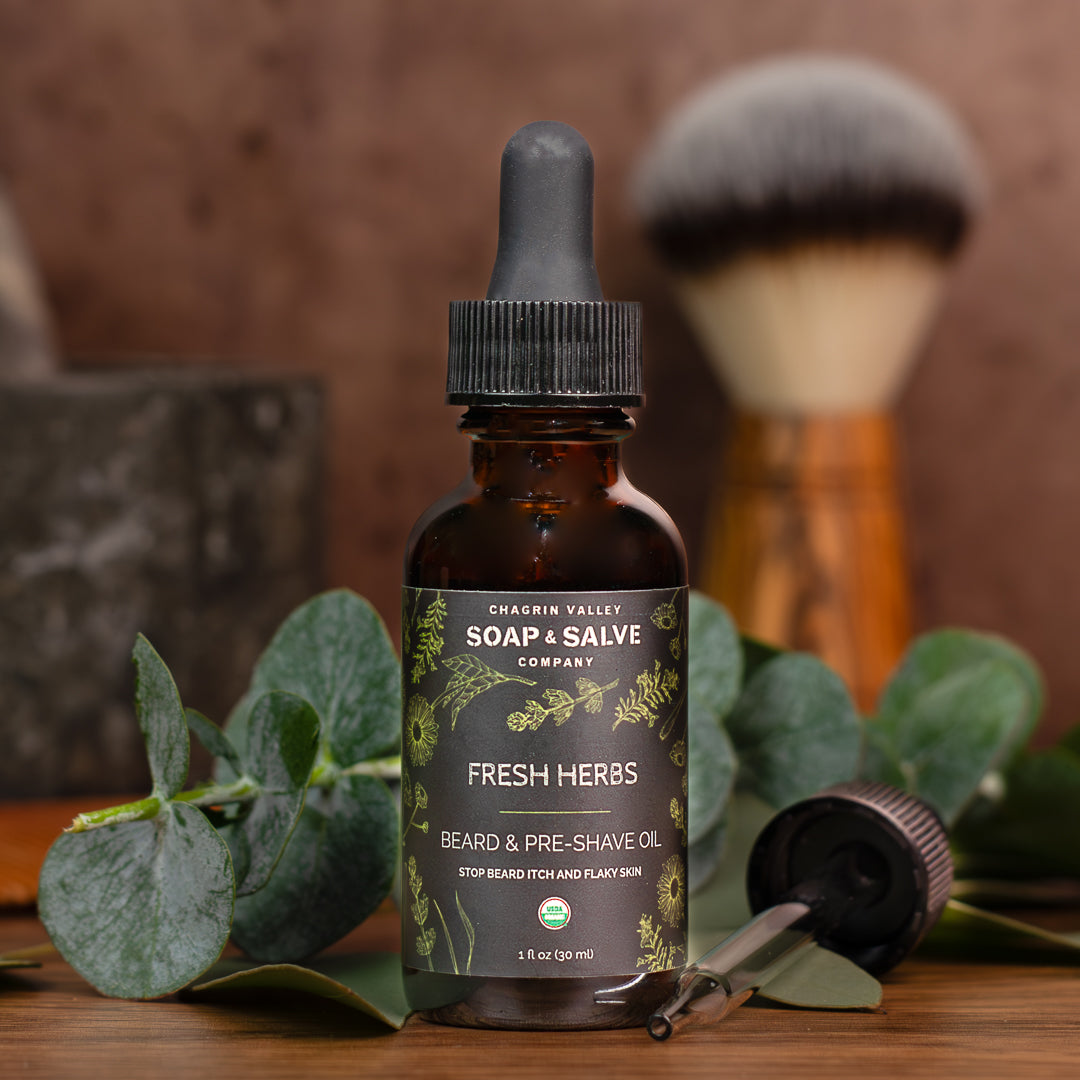
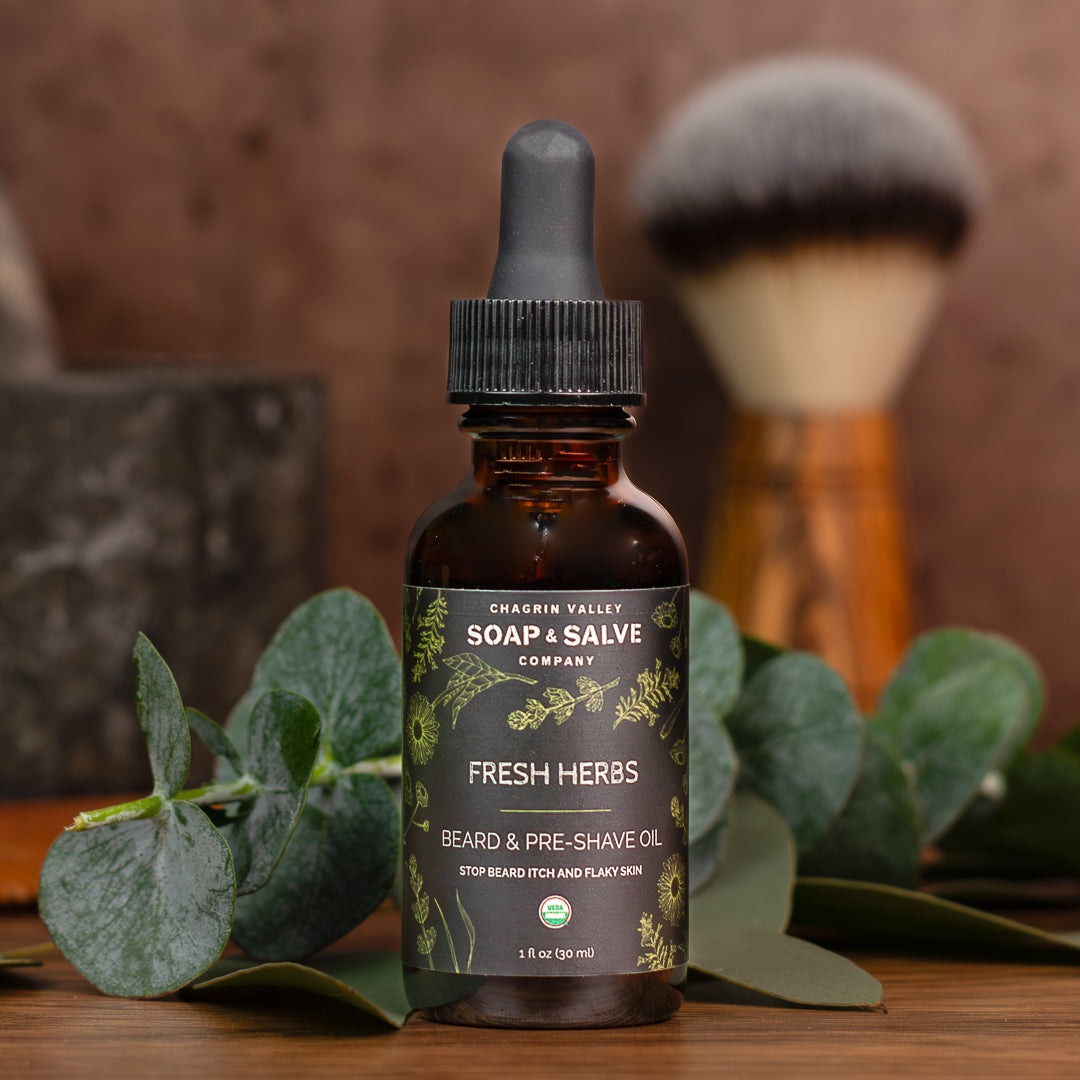
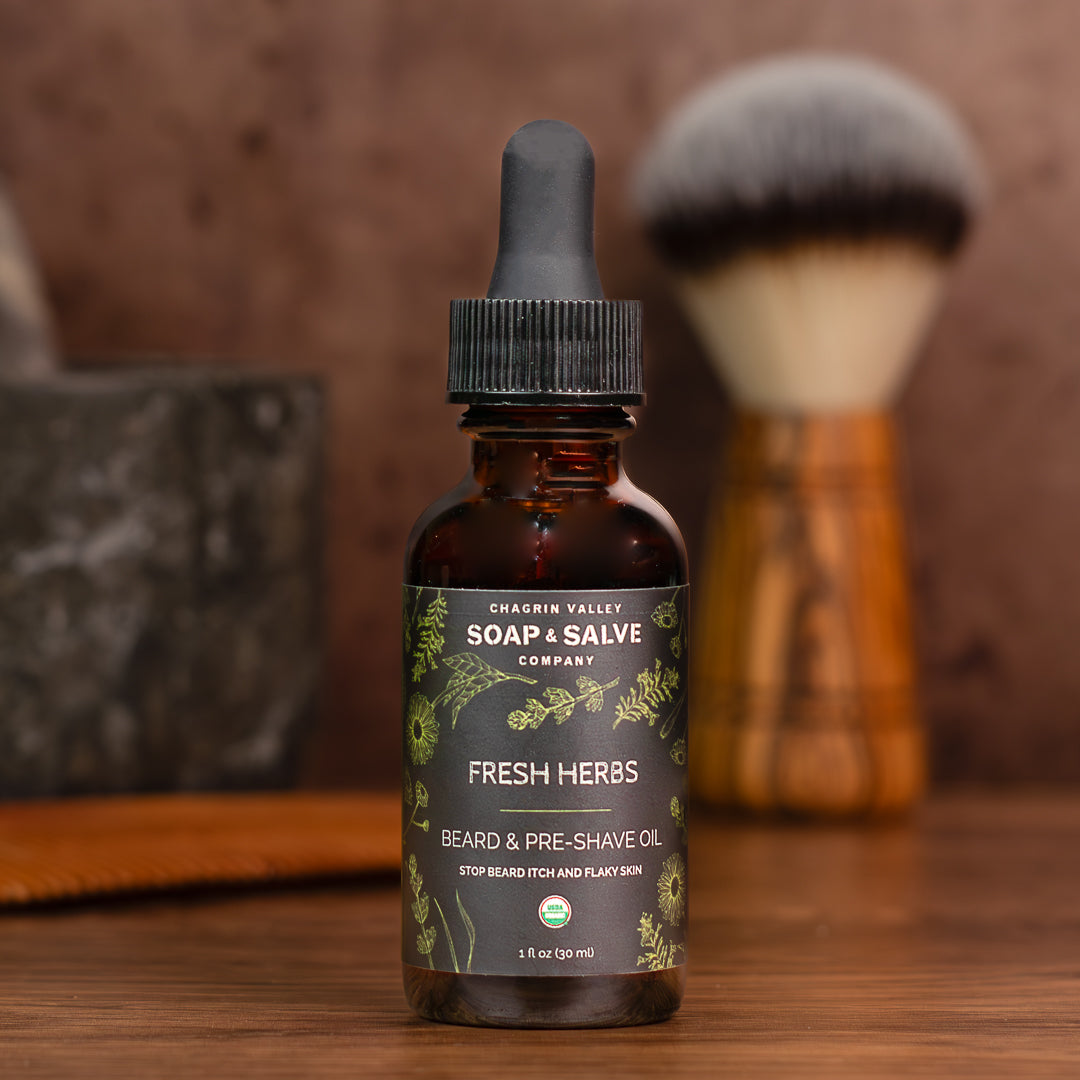
The goal is simple: to Harness the Power & Simplicity of Nature® to cleanse, soothe, heal, and protect your skin and hair!
Our unique formulas rely on moisturizing oils and butters, healing botanicals, and pure essential oils. We choose every ingredient with one end-result in mind….the BEST possible natural skin care for YOU!
 Organic Argan Oil
Organic Argan Oil
 Organic Jojoba Oil
Organic Jojoba Oil
 Organic Basil Essential Oil
Organic Basil Essential Oil
Whether you are shaving your face, underarms, or legs, you will experience the most comfortable close shave if the hair is thoroughly softened with water, and hot water works best.
Directions for a Traditional Mug and Brush Wet-Shave
Begin with cleansed skin to help remove dirt and grime from the hair so that it can absorb water and soften.
Don't have a mug or brush? Once your skin is cleansed, rinsed, and hair is softened, massage the shaving soap onto the area to be shaved to create a rich, foamy lather. Shave as usual.
While everyone has their own special shaving routine, we do recommend shaving in the shower.
Whether you are clean shaven, have a mustache, a bit of a scruff, or a beard, the skin on your face needs moisturizing. This skin-soothing cream is great as an after shave balm to gently soothe freshly shaven skin or as a beard butter to conditioner the beard. It is alcohol-free and will not dry out sensitive facial skin.
Our shave balms are specifically designed to soothe the sore and irritated skin that occurs after shaving. Even if you don't feel the irritation, the uppermost layer of your skin will have lots of tiny abrasions and micro-cuts from the razor blade.
While it might be tempting to slather a thick layer of balm all over your face, especially if it feels irritated, more is not better! The balm should lightly cover all of the freshly shaved skin. If you apply too much, there will be too much to absorb into the skin which can result in a greasy feeling and blocked pores.
If you are unsure how much to use, start small. You can always add more until your learn what your unique face likes.
Our shave blend is a leave-in conditioner that contains a bit of beeswax (not as much as a typical beard balm or wax) which helps tame and smooth flyaways to help style and shape the beard.

The balm ingredients work together to moisturize the skin, soften the beard hair, minimize itchiness, and give your beard a healthy shine.
Our beard butter is also great for mustache hair. Skin under a mustache is often neglected and can easily become dry and flaky.
Whether you are growing a new beard and only have a bit of scruff or your beard is exactly the right length for you, a beard butter does an excellent job keeping both the hair and the skin underneath moisturized.
If you work a beard butter down to the facial skin, you can use beard butter in place of beard oil. Beard butter is designed to keep your beard hairs hydrated and healthy but can also help the skin underneath your beard. But if you choose to use both, apply the beard oil to the skin first before using beard butter.
If you have very sensitive skin or are simply trying a new product for the first time, we always recommend doing a patch test.
For external use only. Discontinue use if irritation occurs. Best if used within 6 months of opening.
Our skin naturally loses the ability to retain moisture as we age. Our facial skin tends to become thinner and lose its elasticity. Our skin also produces less oil, which means it dries out more easily. This can exaggerate the look of fine lines and wrinkles. Facial oils can help prevent water loss and keep skin plump.
Proper hydration is key to retaining a healthy glow. The most basic function of a facial oil is to hydrate and soften the skin by preventing water loss.
For those who have tried facial oils but do not like them, often an incorrect application method is the problem. Since facial oils are very concentrated, a little goes a very long way and less is usually better than more.
If your skin feels oily hours after application, you should reconsider your technique.
Can a face oil replace your moisturizer? For some yes, but for others maybe not. If you have very dry or maturing skin a face oil alone may not contain enough of the "heavier" ingredients found in an organic oil-based moisturizing cream. The two products play different moisturizing roles and support each other.
For my 70 year old facial skin, a face oil alone is enough during summer months but not during the drying winters. If you are going to use both, apply the facial oil first and allow a few minutes for it to absorb before apply your face cream.
The best way to apply facial moisturizers is on freshly cleaned, warm and damp (not wet) skin. Clean skin allows oils to better penetrate deep layers and stop leftover makeup from clogging pores.
Creams and oils work best with a little damp moisture. Facial oils are better able to lock in moisture when the skin is more pliable after a warm wash and damp skin also ensures that the oils spread evenly and absorb effectively into your skin leading to more hydrated, plumper skin.
Note that your skin should not be wet, just a bit moist, or the skin will be unable to hold the oil. Remember that oil and water do not mix!
Again, facial oils are very concentrated, so start slowly. The key is to use them sparingly.
The recommended amount for your décolleté, neck, and face is about 4 to 6 drops. If doing your face only, you need about 2 to 3 drops of oil per treatment. If your skin is extra dry a couple more drops may be helpful. Just don’t overdo it. This might appear to be a very small amount but start out small, you can always add more.
Now that your skin is ready you need to choose an application method.
While many people have their own special technique for applying face oil, here are two favorites. Always be sure that your hands are clean and remember to begin with clean, damp skin.
 We suggest applying our facial oil directly to your skin with the dropper. Placing the oils on your hands first will probably give you soft hands, but you want to get the most benefit for face!
We suggest applying our facial oil directly to your skin with the dropper. Placing the oils on your hands first will probably give you soft hands, but you want to get the most benefit for face!
While it may be called a facial oil, the sensitive skin on your neck is especially prone to signs of aging or dryness.
Begin with only a drop on each cheek, one drop on your neck, one on your décolleté, and one on your forehead, focusing on problem areas (remember you can always add more if needed).
If you choose to do your face only, place one drop on each cheek and one on your forehead. If you have an oily T-zone, but dry flaky cheeks, limit your facial oil application to dry problem areas only.
Patting the oil onto the skin with your fingertips is often thought to be more effective than rubbing the oils into your skin. Patting can aid in oil absorption and nourish deeper skin layers. But using a gentle "rub" in sections will also work, especially if time is a factor.
EYES: Take extra care around the eye area since rubbing or pulling that delicate skin may help encourage those annoying eye wrinkles. My eye technique:
When applying moisturizer to your neck or décolleté, massage in an upward soft stroking motion, until completely absorbed.
A face oil is a great product to use with facial massage. Using small circular strokes in an upward, outward motion, massage slowly and gently with your oily fingertips until most of the oil has been absorbed. The gentle massage will also give your skin a nice circulation boost and can help with lymphatic drainage.
TIPS:
While your skin is still slightly damp, place a few drops of face oil in the palm of one hand and then warm the oil by gently rubbing the palms of your hands together. Then press both your palms onto your face with firm but gentle pressure and hold for a few seconds. Then gently massage until it feels absorbed. Some believe that this warming process helps to better activate all the goodness in your oil and enhance absorption.
It is usually suggested that a facial oil be used in the morning. If your skin is extra thirsty, apply the face oil and allow a few minutes for it to absorb. Then use your natural cream moisturizer as usual for extra hydration.
There is a debate as to whether you should apply moisturizers at night. You need to pay attention to YOUR skin!
One school of thought is that you should not moisturize at night. While you sleep skin cells are hard at work naturally repairing, regenerating, balancing oil production, and flushing out impurities.
Applying moisturizers may prevent your skin from breathing, interfere with the skin’s natural regenerative activities, and may cause your skin to become dependent on moisturizers.
The other school of thought is that since cell repair and regeneration is higher at night, skin loses more moisture and needs the extra moisture. Also, since the skin’s ability to absorb ingredients peaks at night, your skin may be able to better absorb the nourishing, moisturizing ingredients.
When applying a face oil at night, we recommend applying the oil at least 20 to 30 minutes before going to bed. The oil needs time to soak into your skin, rather than into your pillow.
If you choose to moisturize day and night, a light facial oil may be better than a heavy cream. Just remember that your skin needs time to breathe. Using too much over time can make your skin lazy. Over moisturizing signals your own sebaceous (oil) glands to slow down natural moisture production, which can result in chronic dry skin.
If you have very sensitive skin or are simply trying a new product for the first time, we always recommend doing a patch test.
For external use only. Discontinue use if irritation occurs. Best if used within 6 months of opening.
Please Note: Our Sea Buckthorn Oil is unrefined and has a strong fruity musky scent that is characteristic of Sea Buckthorn. Tamanu Oil has a rich, deep scent with a bold dark color. Both oils may naturally separate or solidify at cold temperatures. If your oil solidifies, simply place the bottle in some warm water.
**The deep orange color of sea buckthorn oil can stain skin, clothing, and surfaces. While staining of the skin washes off easily staining of clothes and linens may be permanent.
For more detailed information about face oils please read our blog, "What are Facial Oils and How to Use Them"
Whether you call them "face oils" or "facial serums," nourishing, unrefined organic oils can moisturize, soothe and help restore natural balance to facial skin.
Our skin naturally loses the ability to retain moisture as we age. Our facial skin tends to become thinner and lose its elasticity. Our skin also produces less oil, which means it dries out more easily. This can exaggerate the look of fine lines and wrinkles. Facial oils can help prevent water loss and keep skin plump.
 Application Hint: Apply facial oil right after washing skin and right before any other moisturizer to hold the water on the skin and seal in moisture.
Application Hint: Apply facial oil right after washing skin and right before any other moisturizer to hold the water on the skin and seal in moisture.
While many people, especially those with oily or acne-prone skin tend to shy away from oil-based moisturizing, it can be a very important step in daily skin care. An organic facial oil helps to increase the moisture content in the skin and prevent further moisture loss.
If you have oily skin, nourishing organic oils can help mimic the natural skin sebum which in turn sends signals to oil-producing cells that say, "Hey my skin is moisturized so stop producing oil."
Using products created to "dry out" oily skin, in an attempt to get rid of oily shine, will actually trigger the oil glands to increase oil production, which only exacerbates the oily skin problem. A wholesome moisturizer helps balance skin oil production.
If you have dry skin an organic facial oil made from unrefined botanical oils creates a protective but breathable barrier that slows moisture evaporation and thus helps lock in moisture.
A natural face oil is ideal for sensitive and irritated skin. Sometimes, adequate hydration alone can help calm inflammation and soothe red irritated skin.
It is especially important for those (like me!) with maturing skin to keep your face adequately moisturized to help with fine lines and wrinkles. As we age, the skin's natural oils decreases, the skin dries out more easily and wrinkles appear deeper. A nourishing oil helps prevent water loss and plump the skin.
The main thing is to make sure that you are using the right kind of moisturizer.
The most nourishing face oils are those made with unrefined, certified organic plant-based oils. Unrefined oils are either cold-pressed or expeller-pressed.
They are minimally processed without chemicals under temperature-controlled conditions which ensures a nutrient-rich, high-quality natural oil.
USDA Certified Organic means the botanical oils are free of synthetic additives, pesticides, and preservatives.
Stay away from petroleum-based products that contain mineral oils that clog your pores and cause breakouts.

Creating A Facial Skin Care Routine
What Is A Facial Cleansing Oil? How Do I Use It?

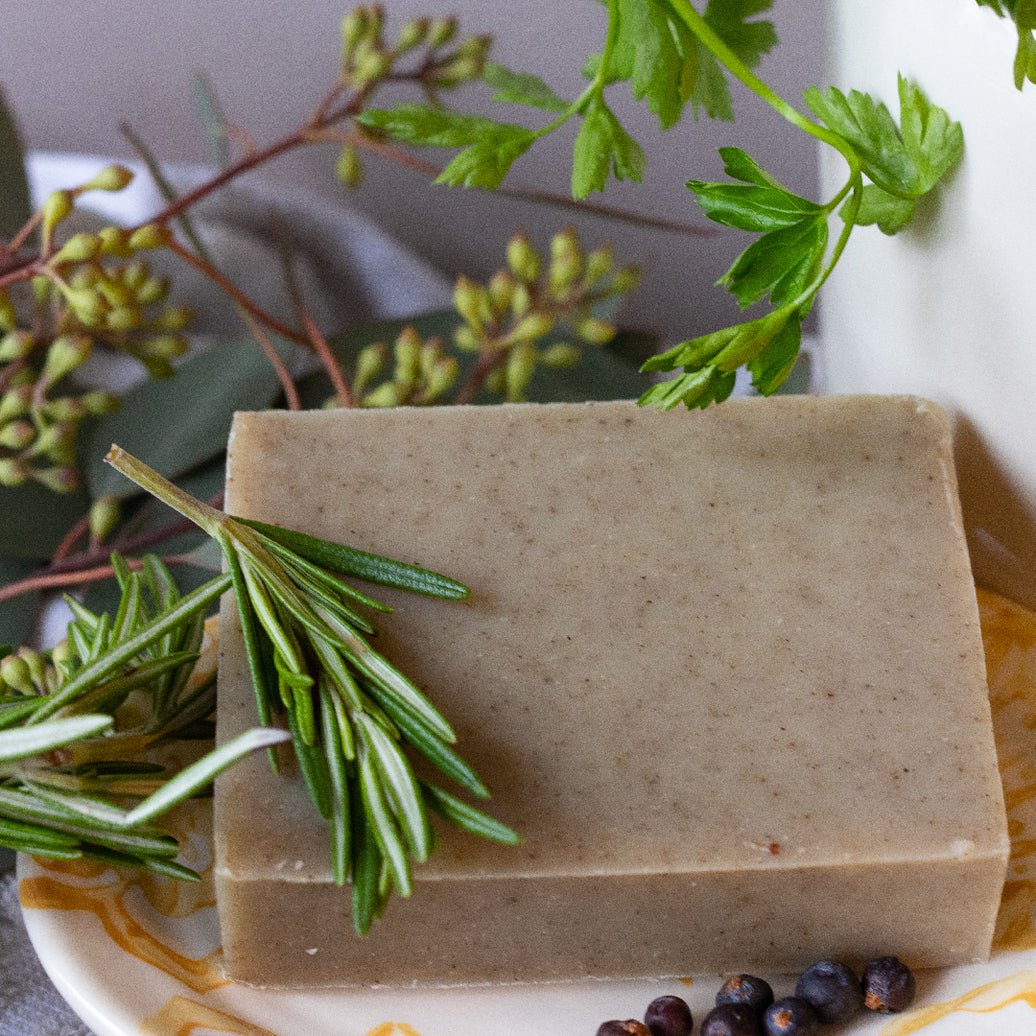
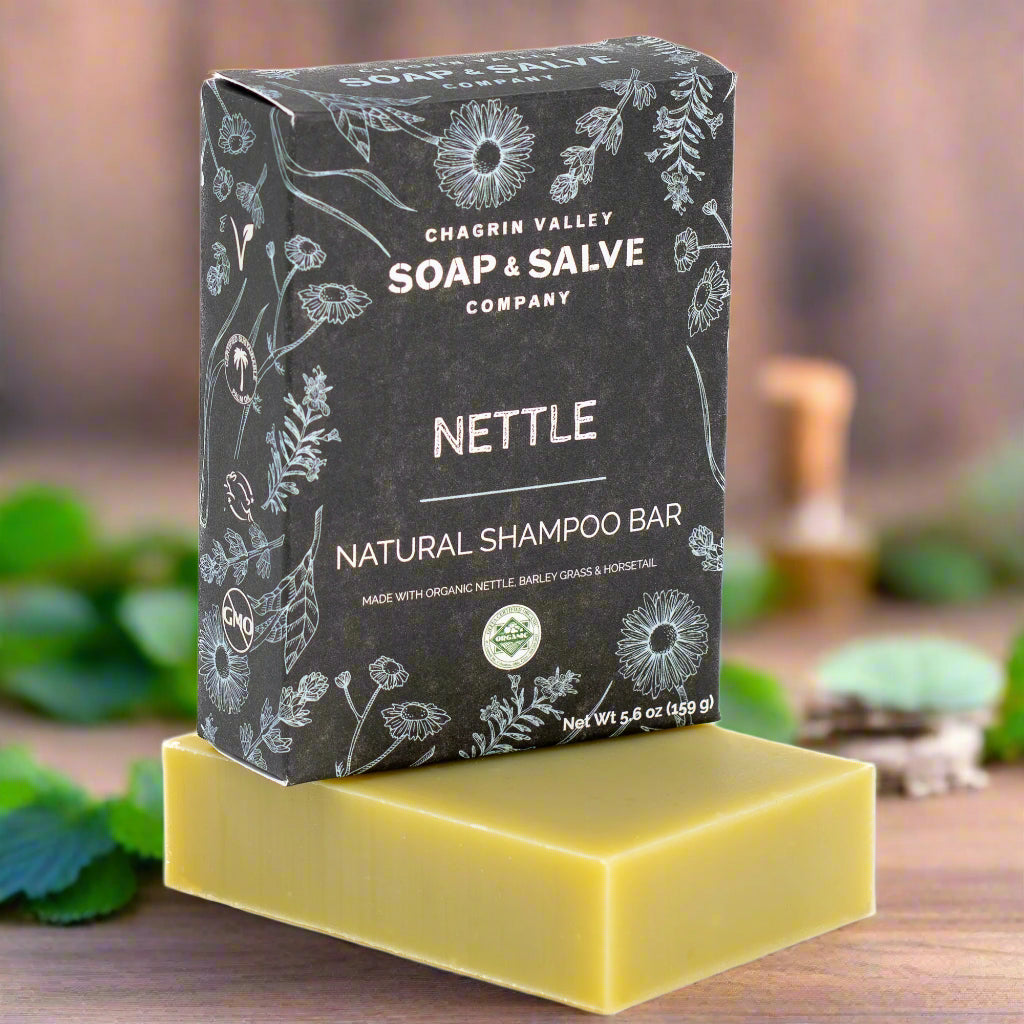
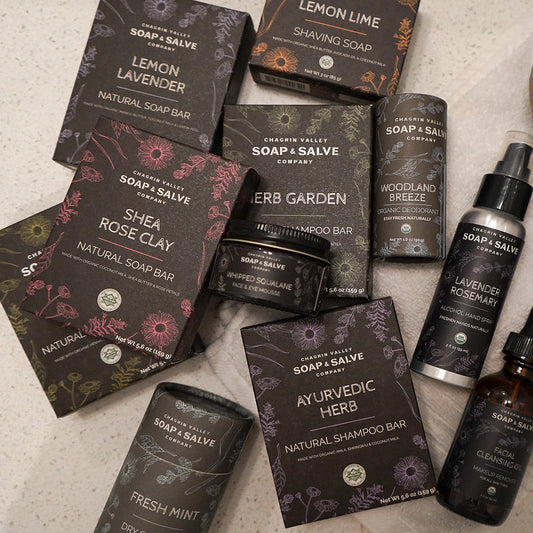
Discover why truly natural and organic skincare matters—for your skin, your health, and the planet. Learn how our USDA-certified products prioritize clean ingredients, sustainability, and transparency and what sets Chagrin Valley apart in a world of misleading beauty industry claims.
Read Post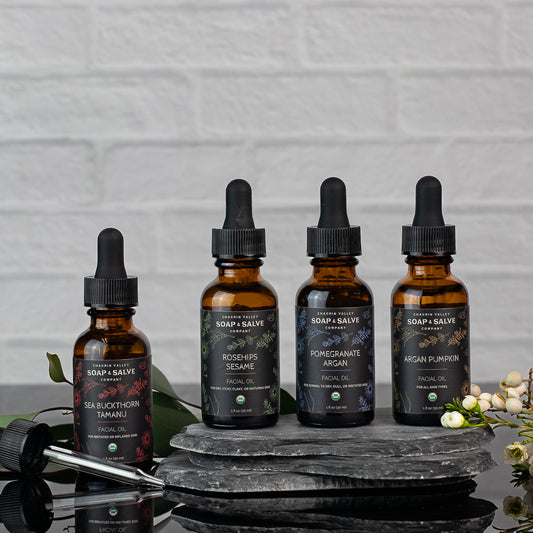
Whether you call them face oils or facial serums, a nourishing organic, unrefined oil can moisturize, soothe and help restore natural balance to facial skin. They are nourishment for beautiful skin.
Read Post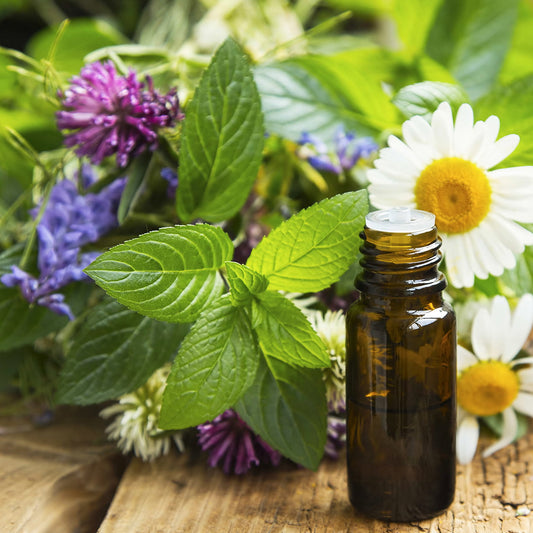
The synergistic composition of essential oils cannot be recreated in a laboratory. Fragrance oils do not offer the natural therapeutic advantages of true essential oils.
Read Post